
IDIA Lab has developed a simulation of Stonehenge in Unity 3D which illustrates the various stages of construction and celestial alignments in an interactive virtual simulator. The project incorporates IDIA Lab’s CelestialEngine which uses NASA JPL data to accurately position the sun, moon and visible planets – correcting for changes in time in the Earth’s rotation and other forces – allowing for accurate observations of the night sky as they would have appeared thousands of years ago at Stonehenge.
The History Channel’s television series The Universe recently shot segments of an upcoming Stonehenge episode at Ball State University’s IDIA Lab and will feature the use of our simulator and rendered animations throughout the hour long episode. http://www.history.com/shows/the-universe/episodes
Press release: https://www.insideindianabusiness.com/newsitem.asp?ID=63067
Simulator video feature walkthrough: http://www.youtube.com/watch?v=fNK-cCIog1E&list=UUtQrLF1JPprEvP4AO-iSNvw&feature=share&index=2
The History Channel’s The Universe, Ancient Mysteries Solved: Stonehenge
Perhaps the most mysterious structure on Earth, Stonehenge has stood on a plain in Southern England for 5000 years. Why is it there? In this episode we explore the possibility that this was a prehistoric astronomical observatory. Here ancient astronomer priests may have divined the complex movements of the Sun and Moon, recognizing patterns that would not be discovered elsewhere for thousands of years. The primitive Shamans may have also been the first astronomers to predict eclipses.
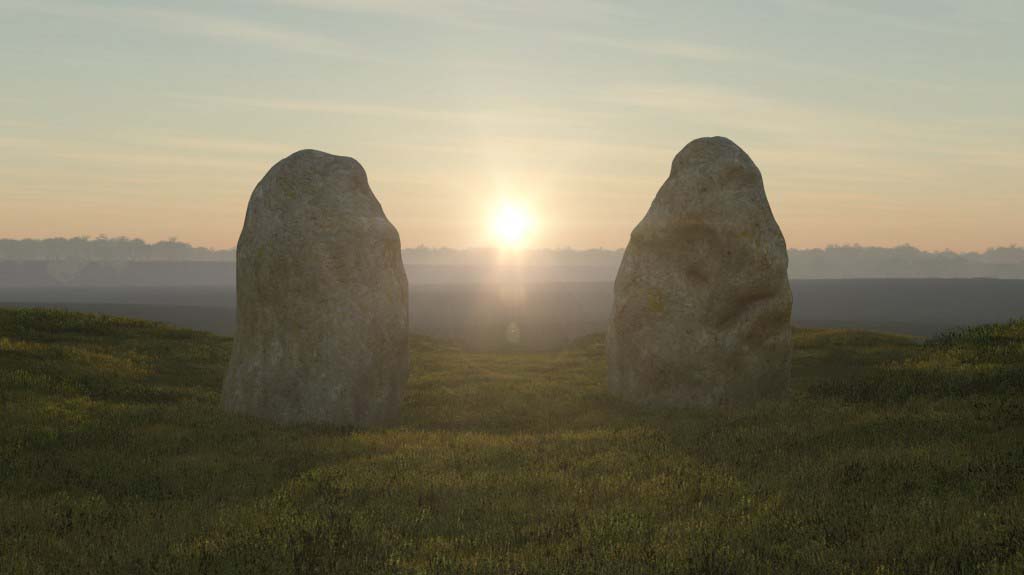
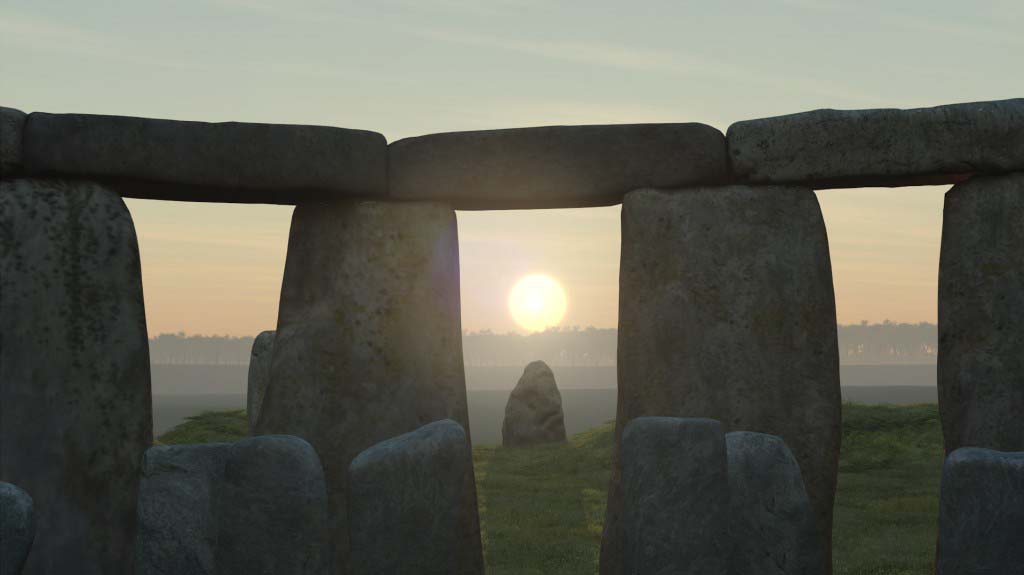

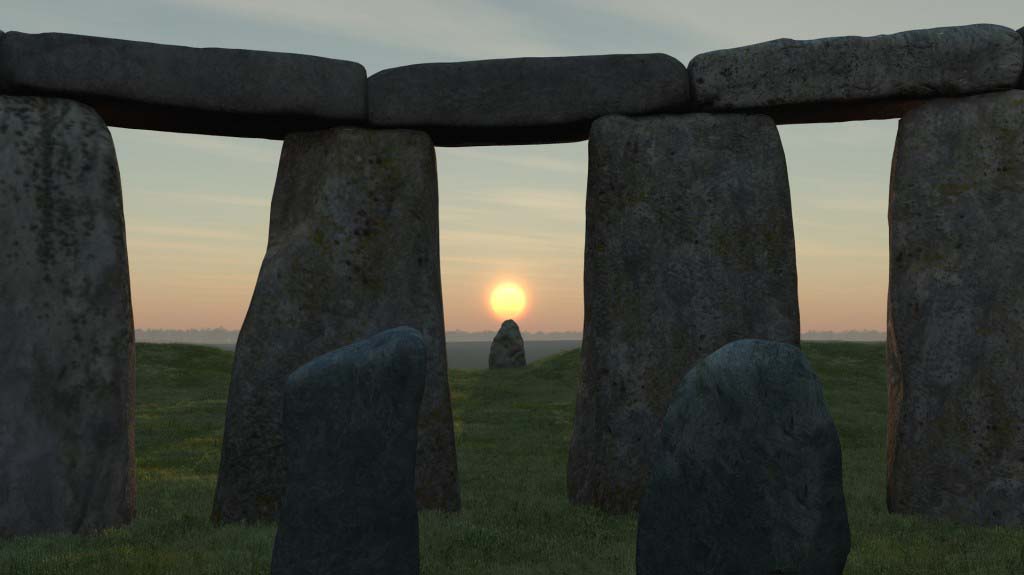

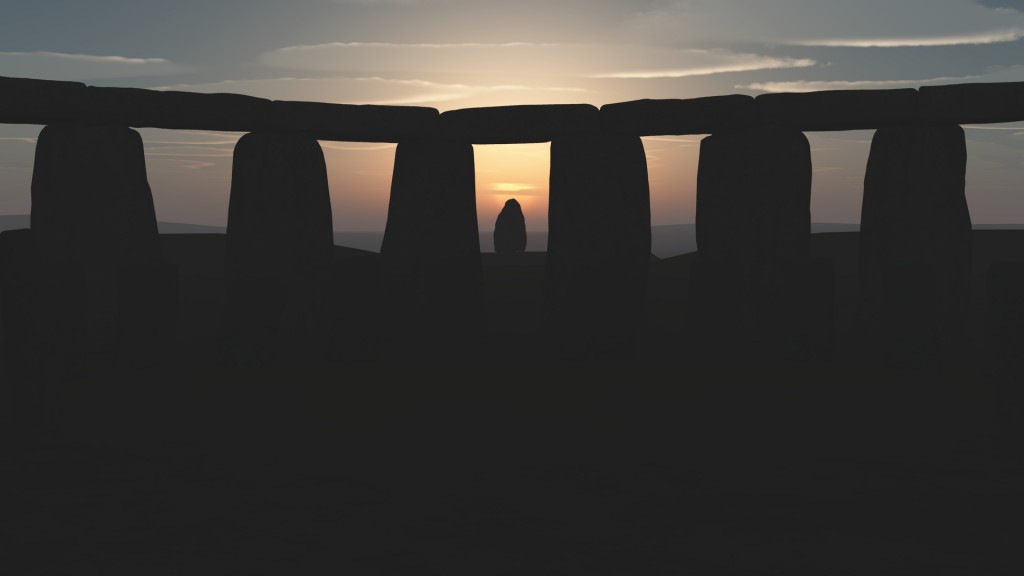
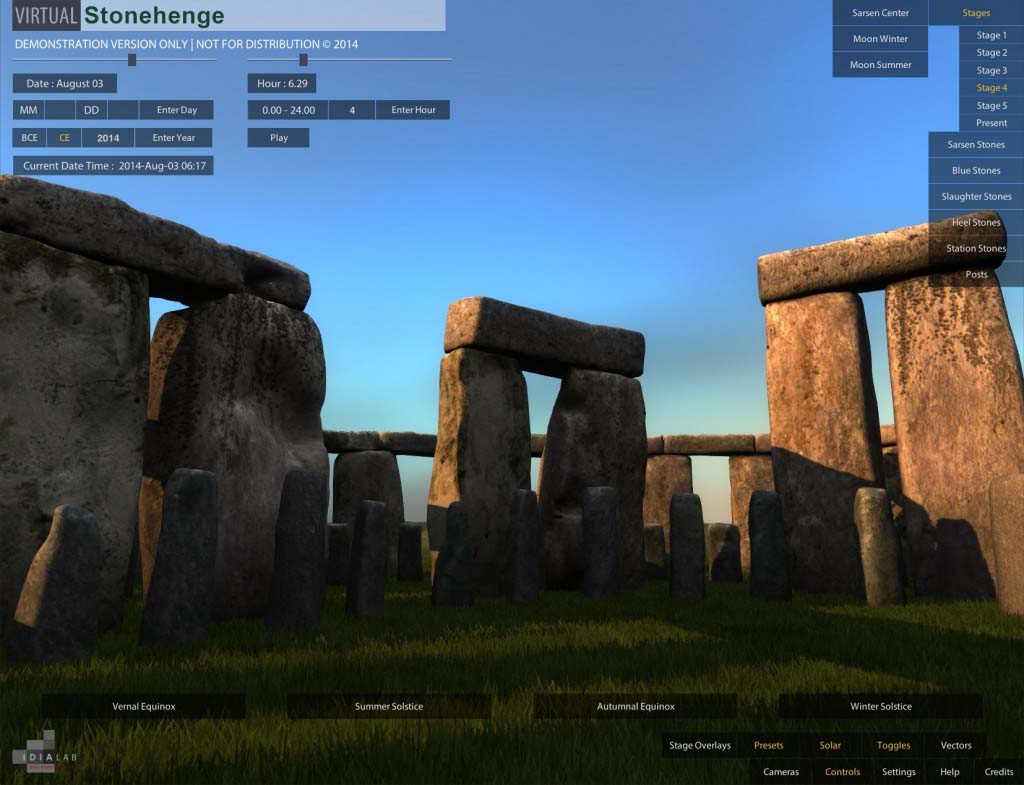
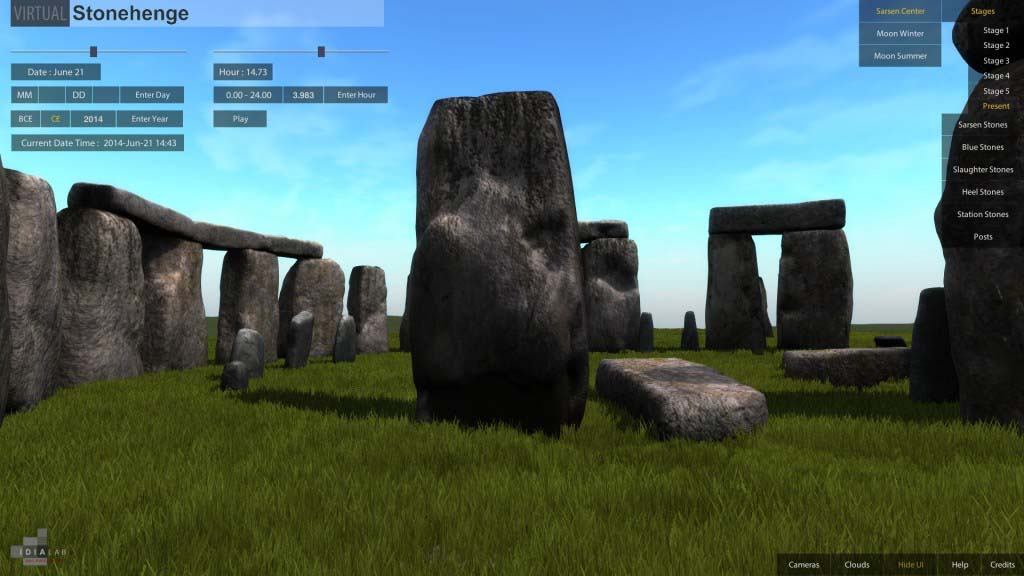

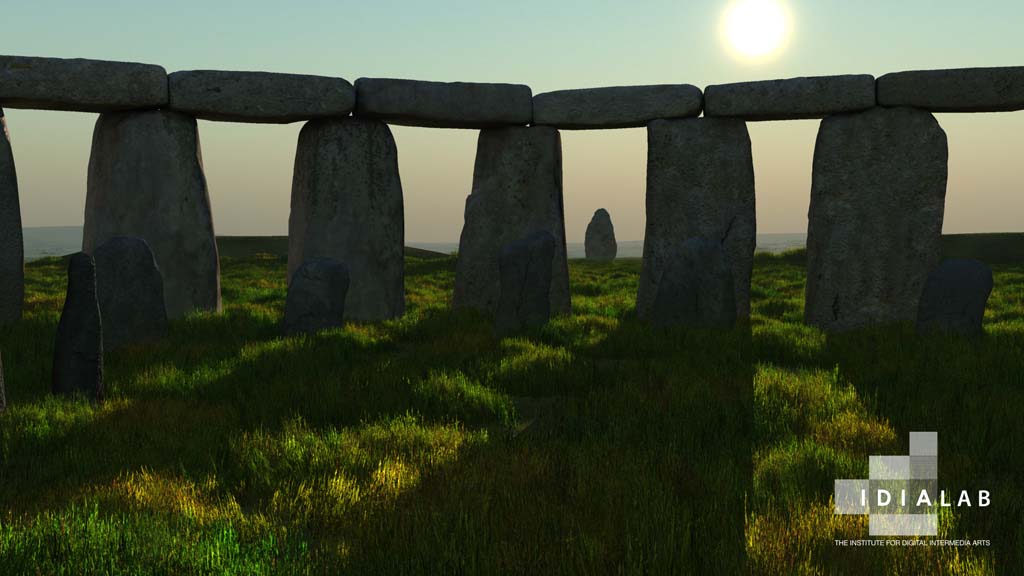

Stonehenge
Introduction
Stonehenge is one of the most famous prehistoric sites in the world – consisting of a ring of standing stones set within large earthworks. It is in the middle of the most dense complex of Neolithic and Bronze Age monuments in England, including several hundred burial mounds.
Archaeologists believe the earliest phases were built approximately around 3000 BC with radiocarbon dating in 2008 suggesting that the first Sarsen stones were raised between 2400 and 2200 BC and that the bluestones may have been raised at the site as early as 3000 BC.
The site and its surroundings were added to the UNESCO‘s list of World Heritage Sites in 1986 in a co-listing with Avebury Henge. It is a national legally protected Scheduled Ancient Monument. Stonehenge is owned by the Crown and managed by English Heritage, while the surrounding land is owned by the National Trust.
Archaeological evidence found by the Stonehenge Riverside Project in 2008 indicates that Stonehenge could have been a burial ground from its earliest beginnings. The dating of cremated remains found on the site indicates that deposits contain human bone from as early as 3000 BC, when the ditch and bank were first constructed.
PHASES
Phase One 3000-2920 BC
The first monument was essentially an earthwork, consisted of a circular bank and ditch enclosure measuring about 110 meters (360 ft.) in diameter, with a large entrance to the northeast and a smaller one to the south. It stood in open grassland on a slightly sloping spot. Within the outer edge of the enclosed bank is a circle of 56 holes each about a meter in diameter, known as the Aubrey holes after John Aubrey, a 17th-century antiquarian who was thought to have first identified them. Current thinking is that the Aubrey holes contained 56 bluestones during this phase of construction. There are suspected to be three heel stones during this era.
Phase Two 2620-2480 BC
Archaeological excavation has indicated that around 2600 BC, the builders reimagined the monument entirely – and began a massive phase of construction. During this period the sarsen ring with horizontal lintels was erected, the “U” shaped cluster of 5 central trilithons. These huge stones, ten uprights and five lintels, weigh up to 50 tons each. They were linked using complex jointing transferred from knowledge of woodworking. Also during this phase an inner ring of bluestones was constructed – most likely from the removal and relocation of the 56 Aubrey hole bluestones.
The earthwork was altered to create two barrows containing the addition of two of the station stones, with the remaining two outside the barrows, forming a rectangle. These station stones have both solar and lunar alignments. The heel stones were reduced to one – which stands somewhat angled today.
Phase Three 2480-2280 BC
In stage three the Avenue was constructed, a long roadway leading to the river Avon and leading to other settlements and monuments. A bluestone circle is constructed inside the ring of trilithons. This phase also noted the appearance of three slaughter stones.
Phase Four 2280-2020 BC
The main alteration of the monument during this period was the reconstruction of the bluestone configuration within the sarsen ring. They were reworked into two distinct patterns, one a central inner oval of 23 stones inside the trilithon ring – the other a circle of 59 stones between the trilithons and the sarsen ring. The remnants of both patterns are visible today. Also, the slaughter stones were reduced to one – which remains in a fallen state.
Phase Five 1680-1520 BC
The site is essentially unchanged with the exception of the construction of the X and Y holes. There are 30 Y holes and 29 Z holes – these are suspected to perhaps have significance in the tracking of the lunar month. The Y and Z Holes are the last known construction at Stonehenge, built about 1600 BC.
Present Day (1600 BC on)
Roman coins and medieval artifacts have all been found in or around the monument but it is unknown if the monument was in continuous use throughout British prehistory and beyond, or exactly how it would have been used. The Romans are believed to have removed 4 of the 23 inner bluestones from the oval, leaving the remaining 19 stones and holes forming the horseshoe we see today. The site was known to scholars during the Middle Ages and since then it has been studied and adopted by numerous groups.
Throughout the 20th century, Stonehenge began to be revived as a place of religious significance, by adherents of Neopagan and New Age beliefs, particularly the Neo-druids.
In the late 1920s a nation-wide appeal was launched to save Stonehenge from the encroachment of the modern buildings that had begun to rise around it. By 1928 the land around the monument had been purchased with the appeal donations, and given to the National Trust to preserve. The buildings were removed (although the roads were not), and the land returned to agriculture. More recently the land has been part of a grassland reversion scheme, successfully returning the surrounding fields to native chalk grassland.
Celestial Alignments
Many astronomical alignments have been attributed to Stonehenge, a complex of megaliths and earthworks in the Salisbury Plain of England. The most famous of these is the midsummer alignment, where the Sun rises over the Heel Stone.
As well as solar alignments, there are proposed lunar alignments. The four station stones mark out a rectangle. The short sides point towards the midsummer sunrise and midwinter sunset. The long sides if viewed towards the southeast, face the most southerly rising of the moon.
Gerald Hawkins, a professor and chair of the astronomy department at Boston University in the United States, published an analysis of Stonehenge in 1965 in which he proposed its purpose as an ancient astronomical observatory predicting movements of sun and stars. Archaeologists and other scholars have since demonstrated such sophisticated, complex planning and construction at other prehistoric earthwork sites across the globe.
Function and Construction
Stonehenge was produced by a culture that left no written records. Many aspects of Stonehenge remain subject to debate. There is little or no direct evidence for the construction techniques used by the Stonehenge builders. Proposed functions for the site include usage as an astronomical observatory or as a religious site.
Professor Michael Parker Pearson of Sheffield University has suggested that Stonehenge was part of a ritual landscape and was joined to Durrington Walls by their corresponding avenues and the River Avon. He suggests that the area around Durrington Walls Henge was a place of the living, whilst Stonehenge was a domain of the dead. A journey along the Avon to reach Stonehenge was part of a ritual passage from life to death, to celebrate past ancestors and the recently deceased. Whatever religious, mystical or spiritual elements were central to Stonehenge, its design includes a celestial observatory function, which might have allowed prediction of eclipse, solstice, equinox and other celestial events important to a contemporary religion.
IDIA Lab Virtual Stonehenge Simulator
IDIA Lab has developed a simulation of Stonehenge that illustrates the various stages of construction and celestial alignments in an interactive virtual simulator. The project incorporates IDIA Lab’s Celestial SimEngine which uses NASA JPL data to accurately position the sun, moon and visible planets – correcting for changes in time in the earths rotation and other forces – allowing for accurate observations of the night sky as they would have appeared thousands of years ago at Stonehenge. https://idialab.org/virtual-stonehenge/
________________________________________
BBC The Sky at Night Episode
This past summer, BBC’s program, The Sky at Night also included IDIA Lab’s Stonehenge simulation and animation in an episode about Stonehenge and the summer solstice. The Sky at Night is a 50 year running program on astronomy which airs on BBC One, Two, Three and Four.
BBC Sky at Night Programme website: http://www.bbc.co.uk/programmes/b036r5nj
Stonehenge pan preview: Stonehenge Sunset Pan